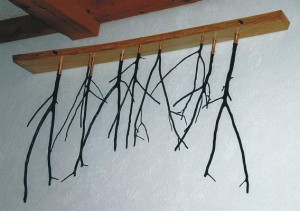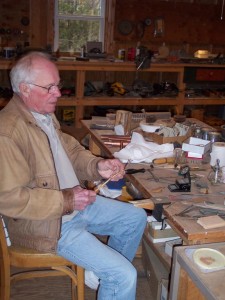Door County Art News: Making Art a Way of Life
- Share
- Tweet
- Pin
- Share
Some people make art for a living. Door County artist Robert Merline makes art a way of life. In his studio, a reconstructed barn on Peninsula Players Road, Merline creates his conceptual pieces; but his century old home, his outbuildings, and his gardens all reflect his artistic vision.
His non-representational pieces are challenging because of their sophistication. “Terminal Feast II,” a commissioned sculpture that he installed in a large Lake Michigan summer home last summer, typifies the artist’s work. Attached like a shelf twelve feet high on an expansive white wall, an oil-finished aspen plank (from locally harvested and milled wood) nine feet long and one foot wide supports nine native red osier branches attached to its bottom with cast bronze couplings and copper tubing. Eight of the branches have been charred while one remains in its natural state. Together, they suggest a fragment of inverted forest.
The wall relief, especially when lit by the afternoon sun, is striking and pleasing but with an engaging tension. “The way I work,” Merline explains, “the pieces are metaphors, with a juxtaposition of manmade and native materials that shows the interrelationship between man and nature, how they co-exist and repel at the same time.

“Terminal Feast Two,” 2007 mixed media (quaking aspen, red osier, copper, cast bronze), 48″ x 96″ x 12″, by Bob Merline.
“I have an idea of what I’m doing and where I’m going,” he said, describing his creative process, “but after the piece is done, it takes on its own life and grows and has different connotations for different people.”
Young Bob Merline became serious about art after serving in the Air Force as an instructor training jet aircraft mechanics. While a mechanical background might seem unusual for an artist, it has proven an asset for Merline, as the meticulous assembly of his sculptures reflects the skills of a highly competent craftsman.
Merline graduated from UW-Madison in 1972 and accepted a position teaching art at Gibraltar High School. After five years he took a leave of absence to begin graduate studies at UW-Milwaukee working as a teaching assistant and earning an MFA in 1977. He returned to Gibraltar where he continued to teach until his retirement in 1999. During this time he also taught art at the Peninsula Art School and the Northeast Wisconsin Technical College.
And throughout his teaching career, he maintained a parallel vocation as a working artist, primarily a sculptor creating pieces, occasionally on a large scale, that require assembly and installation. Often the components will be found natural materials or objects discarded in the environment. “That is how the pieces start,” he said, “bone, old machine parts, irregular tree branches.”
He rarely searches for an artifact. “It shows up,” he said. “I collect it, and it may or may not work as art. It tells me what to do.” He points to a gnarled tree root that had inspired him; he has buffed it to a golden raw wood, an intricate natural sculpture that may eventually become a component of another wall relief.
While all of his work creates a tension among its various components, some of Merline’s earlier pieces do so quite literally, with wood bowed under tension and with lead weights (sometimes hand cast) suspended from cables.
Robert Merline’s work has been exhibited throughout the Midwest, at the Milwaukee Art Museum, the Milwaukee Institute of Art and Design, the Madison Art Center, the Moming Gallery and the Klein Gallery (both in Chicago), the Kit Basquin Gallery in Milwaukee, the Kohler Art Center in Sheboygan, a traveling exhibition through the Wisconsin Academy of Arts, Letters & Sciences, and at many university and private galleries. His work appears in numerous private collections, as well as the permanent collections of the Madison Art Center and the University of Wisconsin.
Locally he has exhibited at Edgewood Orchard Gallery, the Hardy Gallery, and the Miller Art Museum. Last fall his work was included in a sculpture show at the UW-GB Lawton Gallery.
But his work also lives on in the lives of his students, many of whom won local, state, and national awards while still in high school and who now have chosen to make art their life’s work, both as teachers and as professional artists.
Former students recall the comfortable but directed work environment that Merline created for them, a quietly contemplative atmosphere with music and non-threatening opportunities to explore art media. His senior students looked forward to leaving their mark both by painting murals in the school and by collaborating on a graduation wall piece for the art room.
In 1974 Bob Merline and his wife Linda, who teaches at Gibraltar Schools, bought the 1902 stone farmhouse that was part of the Krause Homestead, originally a log cabin built during the mid-1800s.
“There was no water in the house,” Merline recalled. “It had to be plumbed, wired, a new roof and windows, completely gutted and put back together, insulated, plastered.” He did all of the work himself – “I know the house intimately!” he laughs – learning as he went along, by reading, by asking professionals, by trial and error, and by enlisting the help of friends.
“I tried to maintain the character of the house, but make it comfortable,” he explained. He reused materials whenever possible, keeping the same flooring, flipping and reattaching wainscoting, frugality, he said, that he learned from his father.
His goal was to create a space that allowed him to feel comfortable and at peace. “Tonality of color and texture are important to me,” he said, and his living room offers evidence in the form of wood grain and hand-applied plaster, along with his cabinetry and stained glass work. The home is filled with fine art, too, that contributes to the warmth of his space. Some is his own, but all other pieces are the work of artists that he knows personally.
Perhaps the most unique aspect of the artist Robert Merline is the fact that art involves every facet of his life, whether he is creating a commissioned relief sculpture, restoring an historic farmhouse, rebuilding the granary as a garden shed, constructing a studio on the stone basement that once supported a barn, or creating a meditative lookout atop the cement silo of that barn.
He built, again with the help of family and friends, a house for his son Sean (a machinist) and a second for his daughter Erin (a social worker). The gift of his labor and expertise made the homes affordable, as well as comfortable and peaceful, for his children and three grandchildren.
As Merline works, whether building a house, planting a garden, or conceptualizing a piece of art, he tries “to make sense of how you fit into the world.” He attempts “to make peace with how you survive as a living organism without consuming others,” a paradox, he admits, and hence the tension reflected in his artwork.
Subsequently, he is always conscious of the environmental and social impact that he is making, the size of the footprint that he leaves. He and his wife raise all of their vegetables and most of their fruit, and either sell or give away to friends and neighbors any that they can’t use. They raise chickens for the eggs and for an organic fertilizer. They have a solar water heater and drive a hybrid auto. And they recycle and reuse, as Merline does with found and native materials in his art.
“At one time I thought the political process could help improve the environment, but I became disillusioned,” Merline said. “I lost a lot of faith in the political system, as it seems to be self-serving and to have a life of its own. It doesn’t serve the good and betterment of the whole. I don’t know how to change that, so now I participate behind the scenes.”
The wall relief sculpture that Merline created as a commission last summer comes to mind. Of the nine branches in the inverted forest, eight might be charred. But one is still a recognizable red osier.

